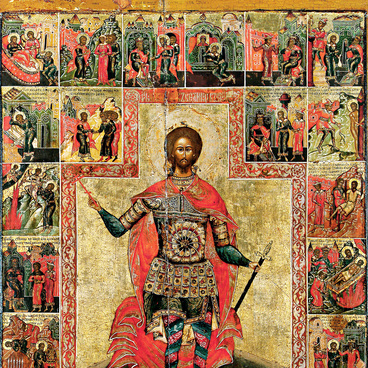The icon, entitled The Resurrection, a descent into hell, with holidays, passions and evangelical scenes, was painted by an unknown artist in 1669. It is dedicated to the feast of Easter or the Resurrection of the Lord. The image was specially made for St. George’s Church in Murom and was part of a group of the five icons, which were presented to the temple by its builder and warden Sidor Lopatin.
Orthodox iconography (except for the later periods) did not display the Resurrection directly. This theme was depicted only symbolically. Therefore, instead of the Resurrection, the Byzantine and Old Rus art depicted either the Appearance of an angel to the myrrh-bearing women, or the Descent into hell.
The canonical Gospels do not describe how Christ went down to hell, bound Satan and brought the Old Testament righteous and prophets led by Adam and Eve out of hell. The biblical texts give only a few references and hints to this event. Its detailed description is found in the apocryphal Gospel of Nicodemus, written in the 2nd century and in the works based on it.
In the centerpiece, the main part of the composition depicts the frontal figure of Christ, who stands on the broken gates of hell, Adam and Eve rising from their coffins and a group of prophets and righteous people led by John the Baptist. He is to the right of the Savior. As an additional subject, the iconographer depicted a scene of the procession of the righteous into heaven and the image of paradise itself. It is enclosed by a wall on all sides, and a righteous thief with a cross in his hands is standing at the gates of paradise. This character is drawn in paradise a second time, talking to the saints.
Such centerpiece composition has been known in Russian art since the middle of the 16th century. Such an iconography gives a detailed interpretation of the main event with the inclusion of additional plot motifs, known from the Apocrypha and Easter saintly teachings. The inner row of the marks on the Murom icon is dedicated to the Twelve Great Feasts (the most important Orthodox holidays after Easter). It is complemented by images of the Conception of the Virgin, the Mid-Pentecost and the Intersession and three scenes of the Passions of Our Lord cycle: the Deposition from the Cross, the Entombment and the Lamentation. The outer row of the stamps, in addition to several festive scenes, illustrates in detail the events associated with the Resurrection of Christ and the appearance of the Savior to his disciples after the Resurrection.
Orthodox iconography (except for the later periods) did not display the Resurrection directly. This theme was depicted only symbolically. Therefore, instead of the Resurrection, the Byzantine and Old Rus art depicted either the Appearance of an angel to the myrrh-bearing women, or the Descent into hell.
The canonical Gospels do not describe how Christ went down to hell, bound Satan and brought the Old Testament righteous and prophets led by Adam and Eve out of hell. The biblical texts give only a few references and hints to this event. Its detailed description is found in the apocryphal Gospel of Nicodemus, written in the 2nd century and in the works based on it.
In the centerpiece, the main part of the composition depicts the frontal figure of Christ, who stands on the broken gates of hell, Adam and Eve rising from their coffins and a group of prophets and righteous people led by John the Baptist. He is to the right of the Savior. As an additional subject, the iconographer depicted a scene of the procession of the righteous into heaven and the image of paradise itself. It is enclosed by a wall on all sides, and a righteous thief with a cross in his hands is standing at the gates of paradise. This character is drawn in paradise a second time, talking to the saints.
Such centerpiece composition has been known in Russian art since the middle of the 16th century. Such an iconography gives a detailed interpretation of the main event with the inclusion of additional plot motifs, known from the Apocrypha and Easter saintly teachings. The inner row of the marks on the Murom icon is dedicated to the Twelve Great Feasts (the most important Orthodox holidays after Easter). It is complemented by images of the Conception of the Virgin, the Mid-Pentecost and the Intersession and three scenes of the Passions of Our Lord cycle: the Deposition from the Cross, the Entombment and the Lamentation. The outer row of the stamps, in addition to several festive scenes, illustrates in detail the events associated with the Resurrection of Christ and the appearance of the Savior to his disciples after the Resurrection.



